UMass Extension's Landscape Message is an educational newsletter intended to inform and guide Massachusetts Green Industry professionals in the management of our collective landscape. Detailed reports from scouts and Extension specialists on growing conditions, pest activity, and cultural practices for the management of woody ornamentals, trees, and turf are regular features. The following issue has been updated to provide timely management information and the latest regional news and environmental data.
The Landscape Message will be updated twice in September. The next message will be posted on September 23. To receive immediate notification when the next Landscape Message update is posted, be sure to join our e-mail list
To read individual sections of the message, click on the section headings below to expand the content:
Scouting Information by Region
Environmental Data
The following data was collected on or about September 7, 2022. Total accumulated growing degree days (GDD) represent the heating units above a 50º F baseline temperature collected via regional NEWA stations (http://newa.cornell.edu) for the 2022 calendar year. This information is intended for use as a guide for monitoring the developmental stages of pests in your location and planning management strategies accordingly.
|
MA Region/Location |
GDD |
Soil Temp |
Precipitation |
Time/Date of Readings |
|||||
|
3-Week Gain |
2022 Total |
Sun |
Shade |
||||||
|
CAPE |
473 |
2370 |
70 |
67 |
0.56 |
12:00 PM 9/7 |
|||
|
SOUTHEAST |
470 |
2498.5 |
70 |
66 |
5.00 |
3:00 PM 9/7 |
|||
|
NORTH SHORE |
448 |
2426 |
65 |
62 |
1.58 |
7:00 AM 9/7 |
|||
|
EAST |
480 |
2679 |
71 |
67 |
3.32 |
5:00 PM 9/7 |
|||
|
METRO |
462 |
2503 |
63 |
61 |
2.88 |
5:30 AM 9/7 |
|||
|
CENTRAL |
467 |
2523 |
72 |
64 |
4.79 |
1:15 PM 9/7 |
|||
|
PIONEER VALLEY |
463 |
2515 |
70 |
65 |
7.17 |
1:00 PM 9/7 |
|||
|
BERKSHIRES |
392 |
2067 |
68 |
63 |
5.22 |
7:00 AM 9/7 |
|||
|
AVERAGE |
457 |
2448 |
69 |
64 |
3.82 |
_ |
|||
|
* = information not available |
|||||||||
As of 9/6, the entire state was in stages of drought ranging from moderate to extreme: Massachusetts | U.S. Drought Monitor (unl.edu) Town watering restrictions: https://www.mass.gov/doc/water-use-restrictions-map/download
Phenology
| Indicator Plants - Stages of Flowering (BEGIN, BEGIN/FULL, FULL, FULL/END, END) | ||||||||
|---|---|---|---|---|---|---|---|---|
| PLANT NAME (Botanic / Common) | CAPE | S.E. | N.S. | EAST | METRO W. | CENT. | P.V. | BERK. |
|
Heptacodium miconioides (seven son flower) |
Full |
* |
* |
Begin |
Begin |
* |
Begin |
* |
|
Clematis terniflora (sweet autumn clematis) |
Begin/Full |
Begin |
* |
Begin |
Begin |
* |
Begin/Full |
Begin |
|
Reynoutria japonica syn. Polygonum cuspidatum (Japanese knotweed) |
Full |
Full |
* |
Full |
Full |
Full/End |
Full |
Full |
|
Hydrangea paniculata (panicle hydrangea) |
End |
Full/End |
* |
Full/End |
Full/End |
Full/End |
Full/End |
Full |
|
Hibiscus syriacus (rose-of-Sharon) |
Full/End |
End |
* |
Full/End |
Full/End |
Full/End |
End |
Full/End |
|
Lythrum salicaria (loosestrife) |
End |
End |
* |
Full/End |
Full/End |
Full/End |
Full/End |
Full/End |
| * = no activity to report/information not available | ||||||||
Regional Notes
Cape Cod Region (Barnstable)
General Conditions: The average temperature for the period from August 17 through September 7 was 71°F with a high of 90°F on August 19 and a low of 49°F on September 3. The majority of the period has had days with highs around 80°F and lows in the upper 60s. Some welcomed cool nights (lows in 50s) occurred on Sept 2 - 4 and some cool days on September 6 and 7 with highs in the mid 60s. Precipitation occurred on at least 5 days during the period, however total accumulation was only just about 0.5”. Precipitation on August 22 & 23 varied extremely, with most of the Cape receiving less than 1/3” while some very limited areas near the canal received close to 3”. Soil moisture is dry and drought conditions continue. Some herbaceous plants seen in bloom include black eyed Susan (Rudbeckia hirta), phlox (Phlox paniculata), hardy hibiscus (Hibiscus moscheutos), boneset (Eupatorium perfoliatum), Russian sage (Salvia yangii), stonecrop ‘Autumn Joy’ (Hylotelephium), goldenrods (Solidago spp.) and some asters. Some woody plants in bloom include butterfly bush (Buddleia davidii), crapemyrtle (Lagerstroemia indica), and Clerodendrum trichotomum.
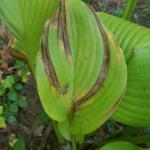

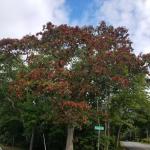 Pests/Problems: Drought conditions are impacting plant health both in natural and man-made landscapes. Wilting, scorch, stress, premature leaf drop, early fall color and death can be seen. Impacts of the drought are likely to result in long term effects on woody plant health. Lawns are crispy. Many lawns are likely to be severely damaged and are unlikely to recover as turf would from dormancy. Insect damage seen during the period includes both pine tip moth damage and turpentine beetle damage to pitch pine. Turpentine beetle is very active for the time of year and stress from pine tip moth and drought are likely to lead to widespread attacks, additional insecticide treatments may be needed to protect high value pitch pines. Flagging as the result of black oak gall wasp damage has been seen in several areas of the mid-Cape. Some flagging on oak can also be seen as the result of fungal cankers (likely Botryosphaeria). Flagging can be differentiated by looking closely at twigs; flagging as a result of Botryosphaeria tends to be on the inner lower crown and flagging as a result of gall wasp on the upper outer crown. Other insects or insect damage seen during the period include Asiatic beetle adults, lacebug on andromeda and azalea, two spotted spider mite on numerous plants, fall tent caterpillar on Callery pear, chilli thrips damage on hydrangea, and sunflower moth damage on echinacea. Disease symptoms and signs seen during the period include pear trellis rust on Callery pear, Volutella blight on boxwood, black spot on rose, cedar apple rust on crabapple, cercospora leaf spot on hydrangea, foliar nematode on hosta and powdery mildew on just about any plant. Weeds seen in bloom include spotted knapweed (Centaurea stoebe), catsear (Hypochaeris radicata), lambsquarters (Chenopodium album), purslane (Portulaca oleracea), horseweed (Conyza canadensis), carpetweed (Mollugo verticillata), perennial sow thistle (Sonchus arvensis), spotted spurge (Euphorbia maculata) and crabgrass. Keep a keen eye out for yellow jacket and bald faced hornet nests while working in unfamiliar landscapes. Keep yourself protected from ticks and mosquitoes. (See Insect Report below for more wasp, tick and other insect information.)
Pests/Problems: Drought conditions are impacting plant health both in natural and man-made landscapes. Wilting, scorch, stress, premature leaf drop, early fall color and death can be seen. Impacts of the drought are likely to result in long term effects on woody plant health. Lawns are crispy. Many lawns are likely to be severely damaged and are unlikely to recover as turf would from dormancy. Insect damage seen during the period includes both pine tip moth damage and turpentine beetle damage to pitch pine. Turpentine beetle is very active for the time of year and stress from pine tip moth and drought are likely to lead to widespread attacks, additional insecticide treatments may be needed to protect high value pitch pines. Flagging as the result of black oak gall wasp damage has been seen in several areas of the mid-Cape. Some flagging on oak can also be seen as the result of fungal cankers (likely Botryosphaeria). Flagging can be differentiated by looking closely at twigs; flagging as a result of Botryosphaeria tends to be on the inner lower crown and flagging as a result of gall wasp on the upper outer crown. Other insects or insect damage seen during the period include Asiatic beetle adults, lacebug on andromeda and azalea, two spotted spider mite on numerous plants, fall tent caterpillar on Callery pear, chilli thrips damage on hydrangea, and sunflower moth damage on echinacea. Disease symptoms and signs seen during the period include pear trellis rust on Callery pear, Volutella blight on boxwood, black spot on rose, cedar apple rust on crabapple, cercospora leaf spot on hydrangea, foliar nematode on hosta and powdery mildew on just about any plant. Weeds seen in bloom include spotted knapweed (Centaurea stoebe), catsear (Hypochaeris radicata), lambsquarters (Chenopodium album), purslane (Portulaca oleracea), horseweed (Conyza canadensis), carpetweed (Mollugo verticillata), perennial sow thistle (Sonchus arvensis), spotted spurge (Euphorbia maculata) and crabgrass. Keep a keen eye out for yellow jacket and bald faced hornet nests while working in unfamiliar landscapes. Keep yourself protected from ticks and mosquitoes. (See Insect Report below for more wasp, tick and other insect information.)
Southeast Region (Dighton)
General Conditions: Here's a handy late summer entomology weather aid in case you've misplaced your trusty thermometer and must know the temperature before choosing to wear a sweater. Dolbear's Law states that the temperature in Fahrenheit can be determined by counting the number of snowy tree cricket (Oecanthus fultoni) chirps produced in fifteen seconds and adding forty. For those using Celsius, the temperature can be found by counting the number of chirps in eight seconds and adding five. We owe our thanks to Margarette W. Brooks (1881) and Amos Dolbear (1897) for determining this valuable scientific formula. Margarette published her research more than a decade earlier than Amos, but Amos got the credit. Unfortunately, this model breaks down as winter nears and temperatures approach freezing because the crickets will die. You'll want to wear a jacket by then anyway.
Daytime temperatures have shifted markedly from highs of 88°F in the latter part of August to the mid 70's in the first week of September. Night temperatures have also dropped over the same period from a high of 72°F on August 23rd to 55°F on September 6th. The change in the weather brought some much needed rains Monday, 9/5 and Tuesday, 9/6, although the distribution appears to be patchy. Humidity remains high. Overall the weather feels more Fall-like since the beginning of September. It looks much like Fall as well. The effects of the severe Summer drought are quite apparent; brown lawns, brown wilted trees and shrubbery are throughout the landscape, especially on south facing slopes. Many plants are also showing early color. However, the recent rains and moderating temperatures have already resulted in growth on surviving turf. Many of the summer blooming perennials are still hanging on although looking very tired. Short day lengths have signaled annuals like petunias to stop flowering and shift energies to seed production. Fruits and berries are coloring up and beginning to litter the grounds underneath their trees. Pollinators include both black and yellow swallowtail butterflies, monarch butterflies, hummingbird moths, blue mud daubers, carpenter bees, and hover flies. The songs of the Orthoptera - crickets, katydids and grasshoppers - have become quite prominent even during the day. Hummingbirds are still present as are flocks of small songbirds. Plants in flower: Albizia julibrissin (mimosa), Ambrosia artemisiifolia (common ragweed), Buddleja (butterfly bush), Franklinia alatamaha (Franklin Tree), Helianthus tuberosus (Jerusalem artichoke), Hibiscus syriacus (rose of Sharon), Hylotelephium telephium 'Autumn Joy' (syn. Sedum telephium), Lagerstroemia (crepe myrtle), Miscanthus (silver grass), Phlox paniculata (garden phlox), Rudbeckia spp. (black-eyed-Susan, cone flower), Salvia yangii (Russian sage), and Solidago spp. (goldenrod).
Pests/Problems: Although mosquito numbers seemed to have been suppressed by drought over the summer, cases of West Nile virus have been reported locally. (See Insect report below.) We should all be on guard again. Fall webworm nests can be observed on red oaks along roadsides. Black faced hornet and yellow jacket nests can be a hazard at this time of year. Be aware of nests both in lawns and trees or shrubbery when pruning.
North Shore (Beverly)
There are data in the Environmental table above but no written report for this issue.
East Region (Boston)
General Conditions: The final two weeks of August averaged 84°F with several minor rain events on the 22nd and 23rd. We had a significant rain event delivering 1.81 inches on the 26th, bringing the total August rainfall to 2.53 inches. September cooled as temperatures averaged 76°F with an overnight low of 52°F on the 2nd. The rain finally arrived on Labor Day Monday continuing through Tuesday. We received steady rain totaling 1.51 inches. Hibiscus moscheutos (hardy Hibiscus), Phlox paniculata (garden Phlox) and Salvia yangii (Russian sage) are attracting pollinators to perennial borders. A late summer flowering Rhus chinensis (Chinese sumac) was in full bloom, loaded with pollinator activity.
Pests/Problems: Despite the refreshing rain many plants are under stress. Early leaf drop is significant throughout the landscape. Powdery mildew is present on dogwood, lilac and Phlox. Landscape weeds in flower include Ambrosia artemisiifolia (common ragweed), Conyza canadensis (horseweed) and Euphorbia maculata (spotted spurge).
Metro West (Acton)
General Conditions: The Labor Day holiday was just celebrated this past weekend and over 0.8” of rain was measured on the Monday holiday providing us with even more to celebrate! Labor Day unofficially marks the end of summer by bringing with it cooler nighttime and pleasant day time temperatures. Soon enough, the fall equinox will be here, arriving on September 22nd. During this reporting period, nighttime temps have dropped and have been recorded in the 40s while the daytime temps have ranged between the mid 70s to low 90s. For August, the monthly average precipitation is 3.72” and the total rainfall recorded for the month was 1.41”, making it the sixth consecutive month this year with below average precipitation recorded. September’s average rainfall is 3.77” and 2.28” of precipitation has been recorded for the month so far. Observed in some stage of bloom this past week were the following woody plants: Boltonia asteroides (Bolton’s aster), Campsis radicans (trumpet vine), Caryopteris clandonensis (blue mist spirea), Chelone lyonii (pink turtlehead), Franklinia alatahama (Franklin tree), Heptacodium miconioides (seven-son flower), Hibiscus moscheutos (swamp mallow), Kirengeshoma palmata (yellow wax bells), Rudbeckia fulgida var. sullivantii 'Goldsturm' (black eyed Susan), and Sedum ‘Autumn Joy’, S. ‘Rosy Glow’ (stonecrops).
Pests/Problems: Not only did we receive a day of rain on Monday, but the rain continued throughout the night and into all day Tuesday, adding 1.48” of rain to the monthly tally. Let’s hope that this weather pattern continues and relieves some of the drought pressure. The flip side of this rain is the flooding and erosion in some areas.
Central Region (Boylston)
General Conditions: As most of us will report, we had substantial rain over the Labor Day holiday. The much needed moisture was quickly soaked up among the gardens. In this reporting period we have had almost 5 inches of rain, which feels monumental compared to what we were previously experiencing. The average air temperature was 72°F, with an average high of 82°F and an average low of 61°F degrees. Although we still had some hot days, this was a welcomed break from the heat we experienced most of the summer. Vernonia noveboracensis (New York ironweed) is holding steady and giving a beautiful electric purple among our wet meadows. Gentiana clausa (closed or bottle gentian) is starting to produce flowers. Euthamia graminifolia (grass-leaved goldenrod) is petering out as Solidago rugosa (wrinkled leaf or rough-stemmed goldenrod) is just starting to bloom.
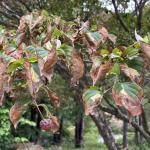
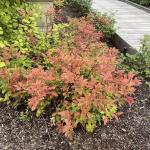
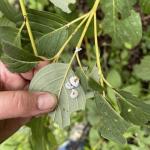
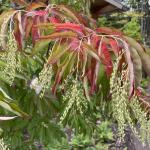 Pests/Problems: We are still experiencing powdery mildew on Cornus spp. (dogwoods), Hamamelis spp. (witch hazel), and the various clovers we typically are weeding. We have started to notice early defoliation and premature dormancy from drought stress, the species that stick out the most are the Itea virginica (summersweet) and Oxydendrum arboreum (sourwood) have already started to turn a beautiful red. Many of our Cornus spp. (dogwoods) and Prunus spp. (flowering cherry) cultivars are losing their leaves quickly and clearly struggling. We have also noticed an increase in the sawfly larvae on Cornus spp. (dogwoods) and Hibiscus moscheutos ‘Summer in Paradise’. This summer's rain events have been more damaging than usual to our beds and pathways, such as the event on August 26/27 which quickly washed away our paths, but we were lucky that the holiday weekend rain fell softly and slowly.
Pests/Problems: We are still experiencing powdery mildew on Cornus spp. (dogwoods), Hamamelis spp. (witch hazel), and the various clovers we typically are weeding. We have started to notice early defoliation and premature dormancy from drought stress, the species that stick out the most are the Itea virginica (summersweet) and Oxydendrum arboreum (sourwood) have already started to turn a beautiful red. Many of our Cornus spp. (dogwoods) and Prunus spp. (flowering cherry) cultivars are losing their leaves quickly and clearly struggling. We have also noticed an increase in the sawfly larvae on Cornus spp. (dogwoods) and Hibiscus moscheutos ‘Summer in Paradise’. This summer's rain events have been more damaging than usual to our beds and pathways, such as the event on August 26/27 which quickly washed away our paths, but we were lucky that the holiday weekend rain fell softly and slowly.
Pioneer Valley Region (Amherst)
General Conditions: Moderate to major drought relief is the headline for this installment of the LM as summer fades into early autumn in the Pioneer Valley. We had another (final?) blast of high heat and humidity on 8/29 and 8/30 with heat indices reaching the mid-90s. This brief dose of swamp heat was a fitting end to a record hot August. According to the NRCC, temperatures were 4–6°F above average throughout much of the valley during our eighth month of the year. Then, as if prompted by the changing of the calendar, a cold front ushered in some beautifully cool weather to start September, with lows on 9/2 reaching the mid-40s. Ah, but that rain. Even before the (pre- and post-) Labor Day storm, there were numerous scattered showers over the last ten days of August (8/22–8/31) with accumulations ranging from: 0.62” (Ashfield), 0.64” (Orange), 1.33” (South Deerfield), 1.41” (Chicopee), 1.69” (Belchertown), 1.82” (Easthampton) and 2.92” (Westfield). While some of these accumulations were modest, any rain was welcome as the landscape attained deeper levels of parchedness. By the end of August, it was easy to find trees and shrubs in early fall color, beginning the dormancy period early due to drought stress. Then, from 9/4–9/6, some truly epic rainfall occurred in some parts of the valley that we could only dream about a few weeks ago. Waves of steady, heavy rainfall, especially on 9/6, resulted in widespread accumulations of 2–5” at many weather stations. The Easthampton gauge recorded a staggering 5.35” over three days. Additional totals included 1.62” (Ashfield), 2.51” (South Deerfield), 2.64” (Orange), 3.23” (Westover Air Force Base, Chicopee), 3.33” (Barnes Airport, Westfield), 4.10 (Charlemont) and 4.41” (Cold Spring Orchard, Belchertown). Overall, it seems that the western hill towns in Hampshire and Franklin Counties fared poorer than the rest of the tri-counties, a trend that has persisted all season. Once again, the southern half of the valley got the largest accumulations. During periods of prolonged drought, rain from fast-moving thunderstorms rarely penetrates deep into the soil. Until the uppermost horizon is properly wetted, much of the rain can sheet away as runoff. At first glance, it can look as if the soil is moist, but scraping away a wetted mulch layer often reveals that very little moisture has penetrated. However, this volume of heavy rain over such a long period allowed for the deep watering that has been lacking for most of the season. For some trees and shrubs, it may be too late to reverse the damaging effects of drought stress. The hope is that many were hanging on and will achieve some level of relief from over a month’s worth of rainfall in one storm. While we may technically remain in some level of drought classification due to the overall water deficit for the year, for some areas the drought is over. The decreasing day length, cooler temperatures and now plentiful soil moisture has made it a great time for new plantings. It was a particularly long summer for nursery stock, so carefully scrutinize new material prior to planting.
Pests/Problems: The dry summer has kept mosquito populations suppressed, so perhaps there will be a late season surge if temperatures remain mild. The moist to wet soils should allow for some root and butt rot pathogens to produce annual mushrooms and conks. The fruiting bodies may be the only indication that some trees are infected. They can be produced anywhere from directly on the lower trunk, to immediately adjacent to the lower trunk, to several feet away from the trunk on lateral surface roots. Now is still a good time to scout for and prune out dead stems and branches that are harboring cankering fungi. When these pathogens overwinter in the canopy, they can sporulate and infect newly developing shoots in the spring. Reduce inoculum levels by removing this diseased material now.
Berkshire Region (Great Barrington)
General Conditions: For much of the past 3 weeks, parts of Berkshire County had been in the abnormally dry or moderate drought condition according to the National Drought Mitigation Center. However, rains earlier this week, i.e. Sept. 5 and 6, brought much relief with the first prolonged rainfall since early June. However, there was much disparity in the amount of rainfall from southern to northern portions of the County. The heaviest rain occurred in South County. At this monitoring site in West Stockbridge, the total for the two days was 2.98 inches. A weather spotter in Great Barrington measured 4 inches for that storm. Lesser amounts occurred in northern County. Temperatures over the 3 week monitoring period have varied from highs in the upper 80s to lows in the lower 40s. Dry soils quickly absorbed the recent heavy rains and brought much relief to drought-stressed vegetation, though at this moment there are areas of turfgrass which have not come out of summer/drought dormancy. The drought has spurred some color change in the foliage of trees but that change is far from the classic fall foliage characteristic of New England forests. Nevertheless, most late summer/early fall blooming herbaceous perennials are putting on a colorful display.
Pests/Problems: Drought stress is the most common problem observed. Foliage of many plants has browned or at least turned yellow. Plants that suffered from spongy moth or other insect damage and/or from leaf and stem diseases have dropped much of their foliage. It is not unusual to see crabapples and roses completely defoliated. Nevertheless, plant pest insects at this time are not dominating. Slugs have been active during the dry spell where landscapes were irrigated and are more prominent now. The most annoying concern is with nuisance pests such as gnats, flies, and various species of wasps.
Regional Scouting Credits
- CAPE COD REGION - Russell Norton, Horticulture and Agriculture Educator with Cape Cod Cooperative Extension, reporting from Barnstable.
- SOUTHEAST REGION - Brian McMahon, Arborist, reporting from the Dighton area.
- NORTH SHORE REGION - Geoffrey Njue, Green Industry Specialist, UMass Extension, reporting from the Long Hill Reservation, Beverly.
- EAST REGION - Kit Ganshaw & Sue Pfeiffer, Horticulturists reporting from the Boston area.
- METRO WEST REGION – Julie Coop, Forester, Massachusetts Department of Conservation & Recreation, reporting from Acton.
- CENTRAL REGION - Mark Richardson, Director of Horticulture reporting from New England Botanic Garden at Tower Hill, Boylston.
- PIONEER VALLEY REGION - Nick Brazee, Plant Pathologist, UMass Extension Plant Diagnostic Lab, reporting from Amherst.
- BERKSHIRE REGION - Ron Kujawski, Horticultural Consultant, reporting from Great Barrington.
Woody Ornamentals
Diseases
Recent pests and pathogens of interest seen in the UMass Extension Plant Diagnostic Lab, a select few:
- Broadleaf (Group 4) herbicide injury on two weeping Norway spruce (Picea abies ‘Pendula’), golden Lawson cypress (Chamaecyparis lawsoniana), Seven-son-flower (Heptacodium miconioides), and eastern redbud (Cercis canadensis ‘Lavender Twist’). A variety of plants, ranging in age from 10- to 20-years-old, at a residential property. The submitted samples exhibited a range of symptoms, which included: undersized foliage that was cupped and blistered (redbud), curled, undersized and distorted foliage (seven-son-flower), browning and shedding needles (Lawson cypress), pale green to brown needles that were irregularly curled (some in a corkscrew pattern) and stems with unnatural downward bending (Norway spruce). There was no evidence of any insects or disease present. It’s unknown what specific product was used but clearly several woody plants were exposed to a non-lethal dose. Susceptibility varies among trees and shrubs to broadleaf herbicides, but improper use can result in serious injury and it may take many years for plants to restore vigor. The lab has received an above-average number of samples this season with evidence of herbicide exposure and injury.
- Canopy dieback of European beech (Fagus sylvatica) caused by the stem and branch cankering pathogens Phomopsis and Asterosporium. The tree is approximately 70-years-old and resides in a large residential yard with full sun and no grass or plants within the canopy drip line. Over the past three years, a progressive thinning and dieback has developed throughout the canopy. Only small diameter stems were submitted but there were no symptoms of beech leaf disease from the foliage. Phomopsis is a generalist that attacks a wide array of stressed trees and shrubs. Asterosporium occurs primarily on beech and produces cankers with cracked, sloughing bark that is covered by a sooty, black coating from its dark-colored spores. Asterosporium can be found on large diameter branches and also appears to be most abundant on weakened and stressed beech trees.
- Verticillium wilt, caused by Verticillium dahliae, of yellowwood (Cladrastis kentukea). The tree was roughly 30-years-old and received a mixture of sun and shade in a landscaped bed next to a shed. The soils are described as primarily clay-based and moderately well-drained. Wilting and dieback symptoms first developed in the canopy in 2021 and this past spring, only about 1/3 of the branches produced flowers. Not all of the canopy is symptomatic but the dieback is progressively worse since last year. The submitted branches and stems had green-colored vascular staining when the bark was shaved and pitting visible when cross-sectional cuts were made. The fungus was readily incubated from the symptomatic wood tissue.
- Stigmina needle cast, caused by Stigmina lautii, on white spruce (Picea glauca) and Norway spruce (P. abies). The Norway spruce is young, approximately five-years-old, and has been present at the site for only four months. It was transplanted to a shaded setting into soils composed of compost and loam, and is irrigated four times a week. While Norway spruce can handle some level of shade, full shade is a stark contrast from the (likely) full sun setting at the nursery where the tree originated. It also appeared to be suffering from shock with shoot tip dieback and collapsed new growth. The white spruce is around 15-years-old and for several years has experienced canopy thinning as older, interior needles die and shed. The tree experiences full sun and the soils were described as dry but there is good air circulation. Additional white spruce nearby have similar symptoms. Presently, only the shoot tips and top of the crown has healthy foliage, which is a typical pattern of needle cast disease development in white (and blue) spruce. No other pathogens or pests were detected from both samples.
- Phytophthora root rot and stem cankering on rhododendron (Rhododendron ‘Weston’s Aglo’, R. ‘Roseum Elegans’, and R. ‘Lee’s Dark Purple’). Young plants at three different sites that were all transplanted from 3–10 months ago. One of the ‘Weston’s Aglo’ was the third plant to die in this specific location. Two previous plants (same cultivar) died shortly after installation. While root rot was the primary cause, the plant was not properly established. There was no attempt to distress the root ball and it was planted too deep. All of the plants had irrigation and otherwise good care following transplant. Symptoms of root disease included blackened and dead fine roots, and brown discoloration of the vascular tissue in lateral roots and the root crown. The stem cankers exhibited sunken and dark-colored bark with orange-colored vascular tissue and pale green, wilted foliage. Infection by Phytophthora species can cause the vascular tissue to become an irregular orange to blue color on some woody plants. It’s very likely, although unconfirmed, that the plants were infected with Phytophthora at the time of planting.
Report by Nick Brazee, Plant Pathologist, UMass Extension Plant Diagnostic Lab, UMass Amherst.
Insects
An Update about Neonicotinoid Use in Massachusetts:
Beginning July 1, 2022 systemic insecticide active ingredients known as neonicotinoids have become state restricted use for tree and shrub uses in Massachusetts. If an individual works in the commercial industry (landscapers, arborists, etc.), then a Commercial Certification License is needed. (Example: Category 36 Commercial Certification License, Shade Trees & Ornamentals.) Someone can use a state or federal restricted use pesticide if they have a Commercial Applicators License as long as they are working under the direct supervision of someone with a Commercial Certification. Unlicensed or uncertified individuals will no longer be able to apply neonicotinoids to manage insect pests of trees and shrubs in Massachusetts.
More information is available, here: https://www.mass.gov/service-details/pesticide-newsupdates
Helpful Information from Taryn LaScola-Miner, Director, Crop and Pest Services Division of the MA Department of Agricultural Resources:
“As you know, products that contain neonicotinoids and have certain use patterns will have a classification change from General Use to Restricted Use on July 1, 2022. In order to help inform the manufacturers, dealers, sellers and applicators of which products will be changing from general use to restricted use, the Department has created the list of neonicotinoid products that currently are and will become restricted use beginning July 1st. You may find the list at the link below. Please note that this list is subject to change.
Additionally, MDAR is anticipating that there will be more of a need for companies to follow the Direct Supervision regulations with this change. Therefore, MDAR has updated its Direct Supervision Frequently Asked Questions document as well.
Although an email will be sent to all licensed applicators within the next few weeks as a final reminder of the change, please pass this information along to your members and customers as an effort to make this transition as smooth as possible. If you have any questions, please let me know. Thank you!”
List of Neonicotinoid Products: https://www.mass.gov/doc/list-of-neonicotinoid-pesticides/download
Direct Supervision Frequently Asked Questions: https://www.mass.gov/doc/direct-supervision-frequently-asked-questions-faq/download
Interesting Insects Reported Recently:
 Katydids: insects in the family Tettigoniidae are referred to as katydids, due to the sounds certain species make when communicating. (Each species has their own unique way of communicating, and not all katydids sound like they are saying “Katy did, Katy didn’t!” on repeat.) They are closely related to the crickets and grasshoppers, and as such another common name for these insects are bush crickets. Many species are green and well camouflaged to hide in nearby plants and are seldom seen and more often heard. (They are typically found in trees and not on the ground.) On occasion, a pink katydid is seen with much excitement. In the case of the insect in this photo from Newton, MA submitted by Megan Margulies on 7/28/2022, they are sometimes both spectacularly pink and green! Katydid females will lay eggs on the soil, plant stems, or on tree bark. The egg stage overwinters. Katydid eggs were observed overwintered on twigs earlier in April of 2022. Eggs hatch and nymphs emerge, which eventually develop into adults. (Katydids have incomplete metamorphosis, so no pupal stage occurs.) Most katydids feed on plant material, but rarely cause any notable or noticeable damage to their host plants. As such, these insects should be preserved in our landscapes.
Katydids: insects in the family Tettigoniidae are referred to as katydids, due to the sounds certain species make when communicating. (Each species has their own unique way of communicating, and not all katydids sound like they are saying “Katy did, Katy didn’t!” on repeat.) They are closely related to the crickets and grasshoppers, and as such another common name for these insects are bush crickets. Many species are green and well camouflaged to hide in nearby plants and are seldom seen and more often heard. (They are typically found in trees and not on the ground.) On occasion, a pink katydid is seen with much excitement. In the case of the insect in this photo from Newton, MA submitted by Megan Margulies on 7/28/2022, they are sometimes both spectacularly pink and green! Katydid females will lay eggs on the soil, plant stems, or on tree bark. The egg stage overwinters. Katydid eggs were observed overwintered on twigs earlier in April of 2022. Eggs hatch and nymphs emerge, which eventually develop into adults. (Katydids have incomplete metamorphosis, so no pupal stage occurs.) Most katydids feed on plant material, but rarely cause any notable or noticeable damage to their host plants. As such, these insects should be preserved in our landscapes.
Insects and Other Arthropods
-
Mosquitoes: The Massachusetts Department of Public Health (DPH) announced on 7/13/2022 that West Nile virus (WNV) had been detected in mosquitoes in Massachusetts for the first time in 2022. The presence of WNV was confirmed by the Massachusetts State Public Health Laboratory in a mosquito sample collected July 11 in the town of Easton, MA in Bristol County. More information about this detection is available here: https://www.mass.gov/news/state-public-health-officials-announce-seasons-first-west-nile-virus-positive-mosquito-sample-3 Since then, additional mosquito samples have tested positive for the virus (WNV). On 9/2/2022 state health officials announced a second human case of West Nile Virus in Massachusetts for 2022: https://www.mass.gov/news/state-health-officials-announce-second-human-case-of-west-nile-virus-in-massachusetts-1 . As of 9/6/2022, no eastern equine encephalitis (EEE) positive mosquito samples, human cases, or animal cases have been detected or reported by DPH.
According to the Massachusetts Bureau of Infectious Disease and Laboratory Science and the Department of Public Health, there are at least 51 different species of mosquito found in Massachusetts. Mosquitoes belong to the Order Diptera (true flies) and the Family Culicidae (mosquitoes). As such, they undergo complete metamorphosis, and possess four major life stages: egg, larva, pupa, and adult. Adult mosquitoes are the only stage that flies and many female mosquitoes only live for 2 weeks (although the life cycle and timing will depend upon the species). Only female mosquitoes bite to take a blood meal, and this is so they can make eggs. Mosquitoes need water to lay their eggs in, so they are often found in wet or damp locations and around plants. Different species prefer different habitats. It is possible to be bitten by a mosquito at any time of the day, and again timing depends upon the species. Many are particularly active from just before dusk, through the night, and until dawn. Mosquito bites are not only itchy and annoying, but they can be associated with greater health risks. Certain mosquitoes vector pathogens that cause diseases such as West Nile virus (WNV) and eastern equine encephalitis (EEE). For local risk levels of WNV and EEE based on state sampling, visit: https://www.mass.gov/info-details/massachusetts-arbovirus-update.
For more information about mosquitoes in Massachusetts, visit: https://www.mass.gov/service-details/mosquitoes-in-massachusetts
There are ways to protect yourself against mosquitoes, including wearing long-sleeved shirts and long pants, keeping mosquitoes outside by using tight-fitting window and door screens, and using insect repellents as directed. Products containing the active ingredients DEET, permethrin, IR3535, picaridin, and oil of lemon eucalyptus provide protection against mosquitoes. Be aware that not all of these can be safely used on young children. Read and follow all label instructions for safety and proper use.
For more information about mosquito repellents, visit: https://www.mass.gov/service-details/mosquito-repellents and https://www.cdc.gov/mosquitoes/mosquito-bites/prevent-mosquito-bites.html .
-
Deer Tick/Blacklegged Tick: Ixodes scapularis adults are active all winter and spring, as they typically are from October through May, and “quest” or search for hosts at any point when daytime temperatures are above freezing. Engorged females survive the winter and will lay 1,500+ eggs in the forest leaf litter beginning around Memorial Day (late May). Larvae are encountered in New England from roughly May through November, with peak risk reported in August. Nymphs are encountered from April through July with a peak risk reported in June in New England. Nymphs may also be encountered again in October and November. For images of all deer tick life stages, along with an outline of the diseases they carry, visit: https://web.uri.edu/tickencounter/species/blacklegged-tick/ .
Anyone working in the yard and garden should be aware that there is the potential to encounter deer ticks. The deer tick or blacklegged tick can transmit Lyme disease, human babesiosis, human anaplasmosis, and other diseases. Preventative activities, such as daily tick checks, wearing appropriate clothing, and permethrin treatments for clothing (according to label instructions) can aid in reducing the risk that a tick will become attached to your body. If a tick cannot attach and feed, it will not transmit disease. For more information about personal protective measures, visit: https://web.uri.edu/tickencounter/prevention/protect-yourself/
The Center for Agriculture, Food, and the Environment provides a list of potential tick identification and testing resources here: https://ag.umass.edu/resources/tick-testing-resources .
-
Wasps/Hornets: Many wasps are predators of other arthropods, including pest insects such as certain caterpillars that feed on trees and shrubs. Adult wasps hunt prey and bring it back to their nest where young are being reared, as food for the immature wasps. A common such example are the paper wasps (Polistes spp.) who rear their young on chewed up insects. They may be seen searching plants for caterpillars and other soft-bodied larvae to feed their young. Paper wasps can sting, and will defend their nests, which are open-celled paper nests that are not covered with a papery “envelope”. These open-celled nests may be seen hanging from eaves or other outdoor building structures. Aerial yellow jackets and hornets create large aerial nests that are covered with a papery shell or “envelope”. Common yellow jacket species include those in the genus Vespula. Dolichovespula maculata is commonly known as the baldfaced hornet, although it is not a true hornet. The European hornet (Vespa crabro) is three times the size of a yellow jacket and may be confused for the northern* giant hornet (Vespa mandarinia). The European hornet is known to Massachusetts, but the northern giant hornet is not. If you are concerned that you have found or photographed a northern giant hornet, please report it here: https://massnrc.org/pests/report.aspx . A helpful ID tool, although developed for Texas by the USDA, depicts common look-a-like species that we also have in MA that can be confused for the northern giant hornet and is found here: https://agrilife.org/lubbock/files/2020/05/Asian_Giant_Hornet_Look-alikes_101_Xanthe_Shirley.pdf . Paper wasps and aerial yellowjackets overwinter as fertilized females (queens) and a single female produces a new nest annually in the late spring. Queens start new nests, lay eggs, and rear new wasps to assist in colony/nest development. Nests are abandoned at the end of the season. Some people are allergic to stinging insects, so care should be taken around wasp/hornet nests. Unlike the European honeybee (Apis mellifera), wasps and hornets do not have barbed stingers, and therefore can sting repeatedly when defending their nests. It is best to avoid them, and if that cannot be done and assistance is needed to remove them, consult a professional.
*For more information about the recent common name change for Vespa mandarinia, please visit: https://entsoc.org/news/press-releases/northern-giant-hornet-common-name-vespa-mandarinia
Woody ornamental insect and non-insect arthropod pests to consider, a selected few:
Invasive Insects & Other Organisms Update:
-
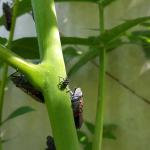
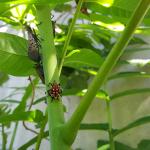
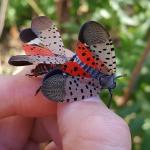
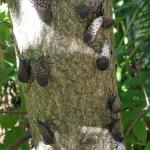
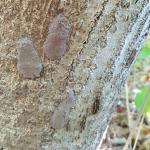 Spotted Lanternfly: (Lycorma delicatula, SLF) is a non-native, invasive insect that feeds on over 103 species of plants, including many trees and shrubs that are important in our landscapes.
Spotted Lanternfly: (Lycorma delicatula, SLF) is a non-native, invasive insect that feeds on over 103 species of plants, including many trees and shrubs that are important in our landscapes.
In the beginning of August 2022, the MA Department of Agricultural Resources (MDAR) announced an additional detection of an established population of the spotted lanternfly in Springfield, MA. MDAR is urging the public to be on the lookout for this pest, especially if they live or work in the Springfield area, and to report it immediately. For more information about the detection in Springfield, visit: https://www.mass.gov/news/state-agricultural-officials-ask-residents-to-report-sightings-of-the-invasive-spotted-lanternfly .
Currently, the only established populations of spotted lanternfly in Massachusetts are in a small area in both Fitchburg and Shrewsbury, MA (Worcester County) and the latest detection of a population of this insect in Springfield, MA (Hampden County; officials are currently working on determining the size of the population in Springfield). Therefore, there is no reason to be preemptively treating for this insect in other areas of Massachusetts. If you suspect you have found spotted lanternfly in additional locations, please report it immediately to MDAR here: https://massnrc.org/pests/slfreport.aspx . If you are living and working in the Fitchburg, Shrewsbury, and Springfield areas, please be vigilant and continue to report anything suspicious.
For More Information:
From UMass Extension:
Check out the InsectXaminer Episode about spotted lanternfly adults and egg masses! Available here: https://ag.umass.edu/landscape/education-events/insectxaminer
Fact Sheet: https://ag.umass.edu/landscape/fact-sheets/spotted-lanternfly
*NEW*: Center for Agriculture, Food, and the Environment: https://ag.umass.edu/news-events/highlights/spotting-spotted-lanternfly
From the MA Department of Agricultural Resources:
Fact Sheet and Map of Locations in MA: https://massnrc.org/pests/pestFAQsheets/spottedlanternfly.html
-
Asian Longhorned Beetle: (Anoplophora glabripennis, ALB) Look for signs of an ALB infestation which include perfectly round exit holes (about the size of a dime), shallow oval or round scars in the bark where a female has chewed an egg site, or sawdust-like frass (excrement) on the ground nearby host trees or caught in between branches. Be advised that other, native insects may create perfectly round exit holes or sawdust-like frass, which can be confused with signs of ALB activity.
The regulated area for Asian longhorned beetle is 110 square miles encompassing Worcester, Shrewsbury, Boylston, West Boylston, and parts of Holden and Auburn. If you believe you have seen damage caused by this insect, such as exit holes or egg sites, on susceptible host trees like maple, please call the Asian Longhorned Beetle Eradication Program office in Worcester, MA at 508-852-8090 or toll free at 1-866-702-9938.
To report an Asian longhorned beetle find online or compare it to common insect look-alikes, visit: http://massnrc.org/pests/albreport.aspx or https://www.aphis.usda.gov/pests-diseases/alb/report .
-
Brown Marmorated Stink Bug: (Halyomorpha halys; BMSB) is a non-native insect first detected in the United States in 1998 in Allentown, PA. This insect was accidentally introduced from Asia. It was first detected in MA in 2007. It has since been reported in multiple counties of MA, but at this time, BMSB is not yet a significant pest of agricultural crops in Massachusetts as it has been in other areas of the United States. BMSB attacks a broad variety of plants, including fruit crops and shade trees. Host plants include but are not limited to: peach, apple, pear, maples, dogwoods, butterfly bush, and vegetable crops. A more comprehensive list of hosts may be found here: https://www.stopbmsb.org/where-is-bmsb/host-plants/ . Brown marmorated stink bugs can be distinguished from native stink bugs by the white bands on the antennae and alternating white and dark bands at the rear edge of the abdomen. Adults emerge around April from their overwintering locations. Females can lay approximately 500 eggs during their lifetime, in clusters of 30 eggs or so at a time, roughly from June-August. Eggs hatch and the immature insects (the nymphs) undergo 5 instars. Adults can be nuisance insects as they become fall home invaders, roughly by the end of September and into October, seeking sheltered locations to overwinter.
More information about BMSB can be found at: https://www.massnrc.org/pests/pestFAQsheets/brownmarmoratedstinkbug.html .
-
Browntail Moth: Euproctis chrysorrhoea is an invasive insect originating from Europe and first detected in the US in Somerville, MA in 1897. Currently, browntail moth is limited to a small portion of eastern Massachusetts, particularly areas near the coast. Report suspected browntail moth life stages here: https://massnrc.org/pests/pestreports.htm . Due to a persistent outbreak of this insect in Maine since approximately 2016, it is a good idea for us to again familiarize ourselves with this pest.
For a great update on the current status of browntail moth in Maine, including excellent photos of newly hatched browntail moth caterpillars compared to a common lookalike (fall webworm), visit: https://content.govdelivery.com/accounts/MEDACF/bulletins/326874e .
Caution: hairs found on the caterpillar and pupal life stages of this insect can cause a rash similar to poison ivy. Some individuals are very sensitive to browntail moth hairs and may also experience allergic reaction. The chance of interacting with browntail moth hairs increases between May and July, although they could be a problem at any time of year.
The larval or caterpillar stage of this insect is present from August until the following June (spending the winter in webs they create on the tips of host plant twigs). In the fall, groups of caterpillars are found creating webs around a tightly wrapped leaf (covered in bright white silk) where they will overwinter in groups of 25-400. These 2-4 inch long webs can be found on the ends of branches often on apple or red oak. As soon as leaves begin to open in the spring (usually by April), the caterpillars will crawl from their webs to feed on the new leaves. Caterpillars are fully grown around June and spin cocoons in which they pupate. These cocoons are also full of the irritating hairs and should be dealt with extreme caution. Adult moths emerge in July and females lay eggs on the undersides of leaves in masses of 200-400, covering them with hairs from their bodies. (Adults do not typically cause skin rashes.) Eggs hatch around August and September and larvae feed shortly before forming their overwintering webs.
The primary concern with this insect are the poisonous hairs found on the caterpillars. Contact with the caterpillar or its hairs can cause a rash similar to poison ivy in susceptible individuals. If hairs break off and blow around in the wind, they can cause difficulty breathing and headaches. While this insect can act as a defoliator in the larval stage, feeding on the leaves of many deciduous trees and shrubs, this activity may be secondary to concerns about public health risks. Care should be taken to avoid places infested with these caterpillars, exposed skin or clothing should be washed, and the appropriate PPE should be worn if working with these insects. Consult your physician if you have a reaction to the browntail moth.
-
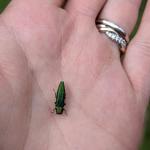 Emerald Ash Borer: (Agrilus planipennis, EAB) has been detected in at least 11 out of the 14 counties in Massachusetts. A map of these locations across the state. Additional information about this insect is provided by the MA Department of Conservation and Recreation.
Emerald Ash Borer: (Agrilus planipennis, EAB) has been detected in at least 11 out of the 14 counties in Massachusetts. A map of these locations across the state. Additional information about this insect is provided by the MA Department of Conservation and Recreation.
This wood-boring beetle readily attacks ash (Fraxinus spp.) including white, green, and black ash and has also been found developing in white fringe tree (Chionanthus virginicus) and has been reported in cultivated olive (Olea europaea). Signs of an EAB infested tree may include D-shaped exit holes in the bark (from adult emergence), “blonding” or lighter coloration of the ash bark from woodpecker feeding (chipping away of the bark as they search for larvae beneath), and serpentine galleries visible through splits in the bark, from larval feeding beneath. It is interesting to note that woodpeckers are capable of eating 30-95% of the emerald ash borer larvae found in a single tree (Murphy et al. 2018). Unfortunately, despite high predation rates, EAB populations continue to grow. However, there is hope that biological control efforts will eventually catch up with the emerald ash borer population and preserve some of our native ash tree species for the future. For an update about the progress of the biological control of emerald ash borer, visit Dr. Joseph Elkinton’s archived 2022 webinar.
-
Jumping Worms: Amynthas spp. earthworms, collectively referred to as “jumping or crazy or snake” worms, overwinter as eggs in tiny, mustard-seed sized cocoons found in the soil or other substrate (ex. compost) that are impossible to remove. The first adults appear in the end of May – June, but the numbers are low and infestations are rarely noticed at that time. It is easy to misidentify earthworms if only immatures found. By August and September, this is when most observations of fully mature jumping worms occur. At that time, snake worms become quite abundant, infestations become very noticeable, and may cause a lot of concern for property owners and managers.
For More Information:
UMass Extension Fact Sheets:
*NEW* Resource with Over 70 Questions and their Answers: Invasive Jumping Worm Frequently Asked Questions:
https://ag.umass.edu/landscape/fact-sheets/invasive-jumping-worm-frequently-asked-questions
Earthworms in Massachusetts – History, Concerns, and Benefits: https://ag.umass.edu/landscape/fact-sheets/earthworms-in-massachusetts-history-concerns-benefits
Jumping/Crazy/Snake Worms – Amynthas spp.:
https://ag.umass.edu/landscape/fact-sheets/jumpingcrazysnake-worms-amynthas-spp
A Summary of the Information Shared at UMass Extension’s Jumping Worm Conference in January 2022:
https://ag.umass.edu/news-events/highlights/jumping-worms-conference
Tree & Shrub Insect Pests, Continued:
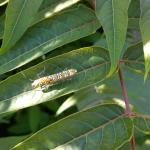 Ailanthus Webworm: Atteva aurea (formerly A. punctella) is a tropical ermine moth from the family Attevidae. While they may be referred to as tropical, apparently the moths themselves can tolerate much colder temperatures than their original host plants. Prior to 1784 when tree of heaven (Ailanthus altissima) was introduced into Philadelphia, PA, the ailanthus webworm was restricted to southern Florida and points south. It would appear that this restriction in distribution was due to the distribution of their original host plants in the genus Simarouba. Once the tree of heaven’s range extended from the north to the south including Florida, the moths were able to move northward on the newly available and suitable host plant. Larvae of this moth feed almost exclusively on tree of heaven in the northern parts of its expanded range. Occasionally, these caterpillars will defoliate tree of heaven, but not to the extent that they could provide any form of control of this invasive tree. (On younger plants, sometimes caterpillars can completely defoliate the trees and strip the bark off of small branches.) Larvae cluster together in a loose web. Larvae of the ailanthus webworm have five white longitudinal lines on an olive-brown colored base with sparsely hairy bodies. Caterpillars are found in the late summer. Larvae pupate within their webs, moths emerge, mate, and then lay their eggs on the outside of the webs. Multiple, overlapping generations can occur per year. These mating ailanthus webworm moths were seen on 8/25/2022 in Springfield, MA.
Ailanthus Webworm: Atteva aurea (formerly A. punctella) is a tropical ermine moth from the family Attevidae. While they may be referred to as tropical, apparently the moths themselves can tolerate much colder temperatures than their original host plants. Prior to 1784 when tree of heaven (Ailanthus altissima) was introduced into Philadelphia, PA, the ailanthus webworm was restricted to southern Florida and points south. It would appear that this restriction in distribution was due to the distribution of their original host plants in the genus Simarouba. Once the tree of heaven’s range extended from the north to the south including Florida, the moths were able to move northward on the newly available and suitable host plant. Larvae of this moth feed almost exclusively on tree of heaven in the northern parts of its expanded range. Occasionally, these caterpillars will defoliate tree of heaven, but not to the extent that they could provide any form of control of this invasive tree. (On younger plants, sometimes caterpillars can completely defoliate the trees and strip the bark off of small branches.) Larvae cluster together in a loose web. Larvae of the ailanthus webworm have five white longitudinal lines on an olive-brown colored base with sparsely hairy bodies. Caterpillars are found in the late summer. Larvae pupate within their webs, moths emerge, mate, and then lay their eggs on the outside of the webs. Multiple, overlapping generations can occur per year. These mating ailanthus webworm moths were seen on 8/25/2022 in Springfield, MA.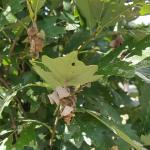
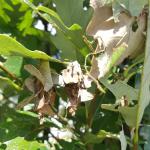
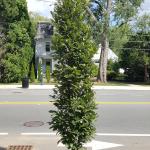
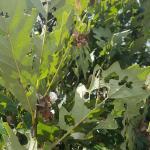
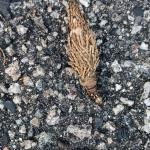
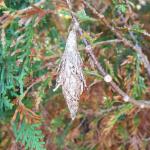 Bagworm: Thyridopteryx ephemeraeformis is a native species of moth whose larvae construct bag-like coverings over themselves with host plant leaves and twigs. Look for caterpillars with cone-like coverings of chewed up leaves, bark, and other plant parts. Common bagworm may be found on evergreen and deciduous host plants. More information can be found here: https://ag.umass.edu/landscape/fact-sheets/bagworm .
Bagworm: Thyridopteryx ephemeraeformis is a native species of moth whose larvae construct bag-like coverings over themselves with host plant leaves and twigs. Look for caterpillars with cone-like coverings of chewed up leaves, bark, and other plant parts. Common bagworm may be found on evergreen and deciduous host plants. More information can be found here: https://ag.umass.edu/landscape/fact-sheets/bagworm .
These caterpillars develop into moths as adults. Their behaviors, life history, and appearance are interesting. The larvae (caterpillars) form “bags” or cases over themselves as they feed using assorted bits of plant foliage and debris tied together with silk. As the caterpillars feed and grow in size, so does their “bag”. Young, early instar caterpillars may feed with their bag oriented skyward, skeletonizing host plant leaves. As these caterpillars grow in size, they may dangle downward from their host plant, and if feeding on a deciduous host, they can consume the leaves down to the leaf veins. Pupation can occur in southern New England in late September or into October and this occurs within the “bag”. Typically, this means that the caterpillars could encounter a killing frost and die before mating could occur. However, in warmer areas of Massachusetts or if we experience a prolonged, warm autumn, it is possible for this insect to overwinter and again become a problem the following season. Bagworm caterpillars are now large and have done much of their feeding for the season in Massachusetts. Mature caterpillars have been reported in Amherst, MA (8/24/2022) and East Bridgewater, MA (8/28/2022). If the larvae survive to pupation, adult male moths emerge and are winged, able to fly to their flightless female mates. The adult male is blackish in color with transparent wings. The female is worm-like; she lacks eyes, wings, functional legs, or mouthparts. The female never gets the chance to leave the bag she constructs as a larva. The male finds her, mates, and the female moth develops eggs inside her abdomen. These eggs (500-1000) overwinter inside the deceased female, inside her bag, and can hatch roughly around mid-June in southern New England. Like other insects with flightless females, the young larvae can disperse by ballooning (spinning a silken thread and catching the wind to blow them onto a new host).
While arborvitae and junipers can be some of the most commonly known host plants for this insect, the bagworm has a broad host range including both deciduous and coniferous hosts numbering over 120 different species. Bagworm has been observed on spruce, Canaan fir, honeylocust, oak, European hornbeam, rose, and London planetree among many others. This insect can be managed through physical removal, if they can be safely reached. Squeezing them within their bags or gathering them in a bucket full of soapy water (or to crush by some other means) can be effective ways to manage this insect on ornamental plants. Early instar bagworm caterpillars can be managed with Bacillus thuringiensis var. kurstaki (Btk) but this is most effective on young bagworms that are approximately no larger than ¾ inch in length. As bagworms grow in size, they may also have behavioral mechanisms for avoiding chemical management. At this point in the season, physical removal (if possible) may be the best option. This will also preserve any natural enemies that would be found attacking this insect, such as certain parasitic wasps. It is also important to note that the bags from dead bagworms will remain on the host plant, so check the viability of the bagworms by dissecting their bags to avoid unnecessary chemical applications. Historically in Massachusetts, bagworms have been mostly a problem coming in on infested nursery stock. With females laying 500-1000 eggs, if those eggs overwinter the population can grow quite large in a single season on an infested host. Typically, this insect becomes a problem on hedgerows or plantings nearby an infested host plant. Thyridopteryx ephemeraeformis is found from Massachusetts to Florida, and is typically a more significant pest in southern climates. However, in recent years (2019-2021), bagworm appears to be overwintering successfully in certain locations in Massachusetts.
-
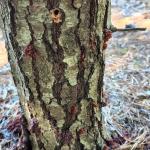
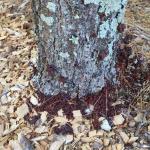
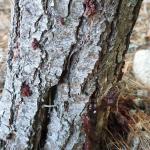 Black Turpentine Beetle: Dendroctonus terebrans adults may begin to be active between mid-April to mid-May, however all life stages, including adults, of this insect may be found throughout the season. Host plants include: black pine (Pinus thunbergiana), eastern white pine (Pinus strobus), Japanese black pine (Pinus thunbergii), loblolly pine (Pinus taeda), pitch pine (Pinus rigida), red spruce (Picea rubens), Scots pine (Pinus sylvestris), and slash pine (Pinus elliottii).
Black Turpentine Beetle: Dendroctonus terebrans adults may begin to be active between mid-April to mid-May, however all life stages, including adults, of this insect may be found throughout the season. Host plants include: black pine (Pinus thunbergiana), eastern white pine (Pinus strobus), Japanese black pine (Pinus thunbergii), loblolly pine (Pinus taeda), pitch pine (Pinus rigida), red spruce (Picea rubens), Scots pine (Pinus sylvestris), and slash pine (Pinus elliottii).
Black turpentine beetle adults and larvae from samples collected in Barnstable County were recently submitted to the UMass Plant Diagnostics Laboratory for identification. This insect is in the same genus as the southern pine beetle (Dendroctonus frontalis) but some useful features and behaviors can be used in the field to distinguish the two from one another. First, the black turpentine beetle (5-8 mm or 5-10 mm are reported in the literature.) has much larger adults than the southern pine beetle (2-3 mm.). Second, the black turpentine beetle tends to limit its attacks of the trunk of its host plants to the lower 6 ft., whereas southern pine beetle caused popcorn-like pitch tubes may be found throughout the entire trunk of the tree. The photos included here show the pitch tubes created by black turpentine beetle activity on the lower trunk of the infested trees. (Photos courtesy of Chad Thomas, 8/18/2022, Barnstable County.)
This is one of the largest native North American bark beetles. In the northern parts of its extensive range, the black turpentine beetle overwinters as an adult in the bark of its hosts. In the southern portions of its range, all life stages may be present throughout the year. As mentioned above, egg laying and feeding is usually kept to the basal 6 feet of the host plant. Mated pairs of adult beetles work to excavate galleries that may be 9.8 inches wide and 11.8 inches long. 100-200 eggs may be laid on one side of the gallery. Once hatched, larvae feed in groups on the inner bark. Fully grown larvae are legless, white, and almost 1/2 inch in length. Pupation occurs and adults eventually emerge from the bark to re-infest the same tree, or disperse to another susceptible host.
Stumps and buttress roots of freshly cut trees are favored by this insect. Attacked trees may exhibit browning of needles and oozing of large masses of pitch. Masses of pitch (pitch tubes) may cover holes in the trunk and may be considerably larger than those of southern pine beetle. Pitch hardens and is first white but may turn red as it ages. Pitch is irregular in shape and up to 1.6 inches in diameter. Pitch tubes are not visible when the area below the soil line is attacked. Healthy trees are usually not attacked, however it has been reported on occasion.
Check drought-stressed or otherwise stressed trees for needles turning light green to rust color. Drought-stressed trees, such as what is so common currently, may be more susceptible to bark beetle attack, including from black turpentine beetle. Also avoid pruning and removal of host plants during the growing season, as these activities can be additionally attractive to the black turpentine beetle. Unless it is a safety hazard, if you are able, wait until the dormant season for these activities. (However, the importance of addressing safety hazards of course outweighs attempts to reduce attracting additional bark beetles.) Check the lower 6 feet, particularly the lower 18 inches, of the trunk for 1.6 inch in diameter pitch tubes or small entrance holes from the adults. Reddish-brown boring dust may be found near the base of the tree as well.
- Fall Home-Invading Insects: Various insects, such as ladybugs, boxelder bugs, seedbugs, and stink bugs (including the invasive brown marmorated stink bug; see entry above) will begin to seek overwintering shelters in warm places, such as homes, throughout the next couple of months. While such invaders do not cause any measurable structural damage, they can become a nuisance especially when they are present in large numbers. While the invasion has not yet begun, if you are not willing to share your home with such insects, now should be the time to repair torn window screens, repair gaps around windows and doors, and shore up any other gaps through which they might enter the home.
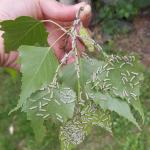 Fall Webworm: Hyphantria cunea is native to North America and Mexico. It is now considered a world-wide pest, as it has spread throughout much of Europe and Asia. (For example, it was introduced accidentally into Hungary from North America in the 1940’s.) Hosts include nearly all shade, fruit, and ornamental trees except conifers. In the USA, at least 88 species of trees are hosts for these insects, while in Europe at least 230 species are impacted. In the past history of this pest, it was once thought that the fall webworm was a two-species complex. It is now thought that H. cunea has two color morphs – one black headed and one red headed. These two color forms differ not only in the coloration of the caterpillars and the adults, but also in their behaviors. Caterpillars may go through at least 11 molts, each stage occurring within a silken web they produce over the host. When alarmed, all caterpillars in the group will move in unison in jerking motions that may be a mechanism for self-defense. Depending upon the location and climate, 1-4 generations of fall webworm can occur per year. Fall webworm adult moths lay eggs on the underside of the leaves of host plants in the spring. These eggs hatch in late June or early July depending on climate. Young larvae feed together in groups on the undersides of leaves, first skeletonizing the leaf and then enveloping other leaves and eventually entire branches within their webs. Tiny, early instar (black-headed) fall webworm caterpillars were observed feeding on birch in Hampshire County, MA on 7/5/2022. At this size, caterpillars skeletonize the leaves as they feed. Webs are typically found on the terminal ends of branches. All caterpillar activity occurs within this tent, which becomes filled with leaf fragments, cast skins, and frass. Fully grown larvae then wander from the webs and pupate in protected areas such as the leaf litter where they will remain for the winter. Adult fall webworm moths emerge the following spring/early summer to start the cycle over again. 50+ species of parasites and 36+ species of predators are known to attack fall webworm in North America. Fall webworms typically do not cause extensive damage to their hosts. Nests may be an aesthetic issue for some. If in reach, small fall webworm webs may be pruned out of trees and shrubs and destroyed. Do not set fire to H. cunea webs when they are still attached to the host plant.
Fall Webworm: Hyphantria cunea is native to North America and Mexico. It is now considered a world-wide pest, as it has spread throughout much of Europe and Asia. (For example, it was introduced accidentally into Hungary from North America in the 1940’s.) Hosts include nearly all shade, fruit, and ornamental trees except conifers. In the USA, at least 88 species of trees are hosts for these insects, while in Europe at least 230 species are impacted. In the past history of this pest, it was once thought that the fall webworm was a two-species complex. It is now thought that H. cunea has two color morphs – one black headed and one red headed. These two color forms differ not only in the coloration of the caterpillars and the adults, but also in their behaviors. Caterpillars may go through at least 11 molts, each stage occurring within a silken web they produce over the host. When alarmed, all caterpillars in the group will move in unison in jerking motions that may be a mechanism for self-defense. Depending upon the location and climate, 1-4 generations of fall webworm can occur per year. Fall webworm adult moths lay eggs on the underside of the leaves of host plants in the spring. These eggs hatch in late June or early July depending on climate. Young larvae feed together in groups on the undersides of leaves, first skeletonizing the leaf and then enveloping other leaves and eventually entire branches within their webs. Tiny, early instar (black-headed) fall webworm caterpillars were observed feeding on birch in Hampshire County, MA on 7/5/2022. At this size, caterpillars skeletonize the leaves as they feed. Webs are typically found on the terminal ends of branches. All caterpillar activity occurs within this tent, which becomes filled with leaf fragments, cast skins, and frass. Fully grown larvae then wander from the webs and pupate in protected areas such as the leaf litter where they will remain for the winter. Adult fall webworm moths emerge the following spring/early summer to start the cycle over again. 50+ species of parasites and 36+ species of predators are known to attack fall webworm in North America. Fall webworms typically do not cause extensive damage to their hosts. Nests may be an aesthetic issue for some. If in reach, small fall webworm webs may be pruned out of trees and shrubs and destroyed. Do not set fire to H. cunea webs when they are still attached to the host plant.-
Hemlock Woolly Adelgid: Adelges tsugae is present on eastern and Carolina hemlock. The overwintering hemlock woolly adelgid generation (sistens) is present through mid-spring and produces the spring generation (progrediens) which will be present from early spring through mid-summer. HWA, unlike many other insects, does most of its feeding over the winter. Eggs may be found in wooly masses at the base of hemlock needles beginning in mid-March. Each wooly mass is created by a female who may then lay 50-300 eggs. Eggs hatch and crawlers may be found from mid-March through mid-July. Infested trees may be treated with foliar sprays in late April to early May, using Japanese quince as a phenological indicator. Systemic* applications may be made in the spring and fall, or when soil conditions are favorable for translocation to foliage. Nitrogen fertilizer applications may make hemlock woolly adelgid infestations worse.
*UMass Extension has recently received questions about systemic active ingredient options that may be used to manage hemlock woolly adelgid as an alternative to neonicotinoid insecticides. A couple of options include but are not limited to: abamectin (avermectin/milbemycin), acephate (organophosphate), and azadirachtin (unknown/uncertain mode of action). General use products are available, and each of these active ingredients are labeled for use on trees and/or shrubs. Many products are labeled for use against hemlock woolly adelgid or adelgids.
Of these active ingredients, azadirachtin is considered to be reduced risk. It is generally considered a safe option for honeybees and other beneficial insects, however some products state that azadirachtin is toxic to fish and other aquatic invertebrates (and as such, the products come with special instructions for precautions when using them near water).
Unlike the neonicotinoids (dinotefuran and imidacloprid, primarily), these systemic active ingredient alternatives do not have efficacy data for the management of hemlock woolly adelgid readily available in the scientific literature. Further research concerning abamectin, acephate, and azadiractin (as well as chlorantraniliprole, a ryanodine receptor modulator/diamide/anthranilic diamide) and their efficacy against hemlock woolly adelgid is needed (McCarty and Addesso, 2019).
Additionally, do not forget that during drought conditions, systemic applications may prove difficult. It is important to follow proper watering practices for high value trees and shrubs in the landscape (while observing local watering restrictions). Watering after systemic applications may improve tree uptake. Follow all label instructions for safety and proper use.
-
Hickory Tussock Moth: Lophocampa caryae is native to southern Canada and the northeastern United States. There is one generation per year. Overwintering occurs as a pupa inside a fuzzy, oval shaped cocoon. Adult moths emerge approximately in May and their presence can continue into July. Females will lay clusters of 100+ eggs together on the underside of leaves. Females of this species can fly, however they have been called weak fliers due to their large size. When first hatched from their eggs, the young caterpillars will feed gregariously in a group, eventually dispersing and heading out on their own to forage. Caterpillar maturity can take up to three months and color changes occur during this time. These caterpillars are essentially white with some black markings and a black head capsule. They are very hairy, and should not be handled with bare hands as many people can have skin irritation or rashes (dermatitis) as a result of interacting with hickory tussock moth hairs. By late September, the caterpillars will create their oval, fuzzy cocoons hidden in the leaf litter where they will again overwinter. Hosts whose leaves are fed upon by these caterpillars include but are not limited to hickory, walnut, butternut, linden, apple, basswood, birch, elm, black locust, and aspen. Maple and oak have also been reportedly fed upon by this insect. Several wasp species are parasitoids of hickory tussock moth caterpillars.
- Lacebugs: Stephanitis spp. lacebugs such as S. pyriodes can cause severe injury to azalea foliage. S. rhododendri can be common on rhododendron and mountain laurel. S. takeyai has been found developing on Japanese andromeda, leucothoe, styrax, and willow. Stephanitis spp. lace bug activity should be monitored through September. Before populations become too large, treat with a summer rate horticultural oil spray as needed. Be sure to target the undersides of the foliage in order to get proper coverage of the insects. Certain azalea and andromeda cultivars may be less preferred by lace bugs.
-
Tuliptree Aphid: Illinoia liriodendri is a species of aphid associated with the tuliptree, wherever it is grown. Depending upon local temperatures, these aphids may be present from mid-June through early fall. Large populations can develop by late summer. Some leaves, especially those in the outer canopy, may turn brown or yellow and drop from infested trees prematurely. The most significant impact these aphids can have is typically the resulting honeydew, or sugary excrement, which may be present in excessive amounts and coat leaves and branches, leading to sooty mold growth. This honeydew may also make a mess of anything beneath the tree. Wingless adults are approximately 1/8 inch in length, oval, and can range in color from pale green to yellow. There are several generations per year. This is a native insect. Management is typically not necessary, as this insect does not significantly impact the overall health of its host. Tuliptree aphids also have plenty of natural enemies, such as ladybeetles and parasites.
-
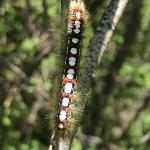
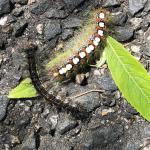 White Satin Moth: Leucoma salicis has again been reported from Beartown State Forest (Berkshire County) on 6/8/2022 by the Massachusetts Department of Conservation and Recreation, Forest Health Program (photos courtesy of Eric Reynolds). This is the same location that caterpillars of this species were seen defoliating their hosts in 2020 and 2021.
White Satin Moth: Leucoma salicis has again been reported from Beartown State Forest (Berkshire County) on 6/8/2022 by the Massachusetts Department of Conservation and Recreation, Forest Health Program (photos courtesy of Eric Reynolds). This is the same location that caterpillars of this species were seen defoliating their hosts in 2020 and 2021.
The caterpillars of this species have a unique color pattern, which helps us distinguish them from others. The dorsal (back) side of the caterpillar is marked with 10-11 white, intersegmental spots as well as paired, red “setal warts”. The sides of the caterpillars are blueish gray. These caterpillars are known to the edges of waterways, woodlands, and forests from Canada to northwestern Connecticut and central New York. One generation occurs per year with mature caterpillars known in May and June. Host plants include aspen, poplar, and willow, the leaves of which are fed upon by the caterpillars of this species.
The white satin moth was introduced from Europe and first reported between Boston, MA and Hampton, New Hampshire in 1920. This insect is said to overwinter in the third instar (caterpillars pass through seven instars), either individually or in small groups. In the springtime, caterpillars leave their areas of hibernation to feed on nearby leaves. Caterpillars spin a thin cocoon between leaves or between exfoliating or thick bark crevices. Pupae are dark brown/black and often in a thin, loose silken sack. Pupae also sport brightly colored, yellow setae (hairs) that make them quite attractive. Pupation begins by the end of June. Shortly thereafter, moths emerge and females lay egg masses covered in a frothy, white material from July – mid-August. Eggs hatch sometime in August, and larvae will conduct feeding in August and September.
While caterpillars of this species are not noted to be of particular concern with regard to causing allergic reactions such as dermatitis, they are a type of tussock moth and do possess hairs, so they should not be handled and should be approached with caution particularly by sensitive individuals.
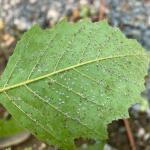 Witchhazel Leaf Gall Aphid: Hormaphis cornu is the species responsible for springtime cone-shaped galls on the upper leaf surfaces of witchhazel. These aphids overwinter in the egg stage, hatching when new leaves are developing and begin to feed, thus inducing gall development on that host. By late spring or early summer, they migrate to river birch, where the life stage present on that host more closely resembles a scale insect or a mulberry whitefly nymph. On river birch, the life stage is known as the “aleurodiform” or “whitefly form” of the aphid. By the late summer, this life stage gives birth to the nymphs that develop wings which will fly back to witchhazel to give birth to the wingless generation that lays overwintering eggs on that host. On 8/25/2022, the aleurodiform aphids were seen on river birch in Massachusetts and photographed by Kyle Kaseta, MA Department of Agricultural Resources. It is easy to see how these insects could be confused for scales or whiteflies! For more information about the witchhazel leaf gall aphid, visit: https://content.ces.ncsu.edu/witchhazel-leaf-gall-aphid . To learn more about the mulberry whitefly, and see photos of the life stage that looks so much like these aleurodiform aphids, visit: https://bygl.osu.edu/node/763 .
Witchhazel Leaf Gall Aphid: Hormaphis cornu is the species responsible for springtime cone-shaped galls on the upper leaf surfaces of witchhazel. These aphids overwinter in the egg stage, hatching when new leaves are developing and begin to feed, thus inducing gall development on that host. By late spring or early summer, they migrate to river birch, where the life stage present on that host more closely resembles a scale insect or a mulberry whitefly nymph. On river birch, the life stage is known as the “aleurodiform” or “whitefly form” of the aphid. By the late summer, this life stage gives birth to the nymphs that develop wings which will fly back to witchhazel to give birth to the wingless generation that lays overwintering eggs on that host. On 8/25/2022, the aleurodiform aphids were seen on river birch in Massachusetts and photographed by Kyle Kaseta, MA Department of Agricultural Resources. It is easy to see how these insects could be confused for scales or whiteflies! For more information about the witchhazel leaf gall aphid, visit: https://content.ces.ncsu.edu/witchhazel-leaf-gall-aphid . To learn more about the mulberry whitefly, and see photos of the life stage that looks so much like these aleurodiform aphids, visit: https://bygl.osu.edu/node/763 .
Concerned that you may have found an invasive insect or suspicious damage caused by one? Need to report a pest sighting? If so, please visit the Massachusetts Introduced Pests Outreach Project: http://massnrc.org/pests/pestreports.htm .
Reported by Tawny Simisky, Extension Entomologist, UMass Extension Landscape, Nursery, & Urban Forestry Program
Weeds
- The flowering period of Japanese knotweed (Polygonum cuspidatum syn. Reynoutria japonica) is right on time, so now is the time to begin your herbicide applications. Glyphosate-based herbicide products are the best choice for the control of Japanese knotweed. In areas near water, a formulation of glyphosate that is labeled for these areas should be used. Non-chemical products containing clove oil, citric acid, acetic acid or orange extract will not effectively control Japanese knotweed.***
- Now is a great time to treat poison ivy. Glyphosate or triclopyr are the best herbicides for poison ivy control and applications can be done from now to late September as long as the leaves are still green. Triclopyr products should be selected over glyphosate products in areas where grasses need to be saved. Contact (Scythe, Reward) or the non-chemical/organic herbicide products will provide “burndown” activity only and will not adequately control poison ivy.
- Common reed or phragmites (Phragmites australis) is starting to flower in New England so now is the time to treat this invasive plant. Glyphosate-based herbicide products are the best choice for the control of common reed. In areas near water, a formulation of glyphosate that is labeled for these areas should be used.***
- At this point in the season, summer annual weeds in landscape beds have become very large. Treating them with a non-selective herbicide will result in unsightly dead vegetation, so hand weeding may be necessary. Consider physical removal followed by a fresh mulch layer. A fresh layer of mulch will cover any plants you could not remove as well as provide protection against winter annual weeds.
- Scout for weeds that may be creeping into beds from adjacent turf areas. Use a non-selective herbicide or a graminicide (clethodim for perennial grassy weeds) to edge the bed.
- Many landscape trees produce vegetative suckers at the base of trees. Suckers are commonly seen on crabapple, flowering cherry, flowering pear, plum, linden, maple and sometimes oak. Honeylocust commonly produces vegetative sprout along the entire length of their trunk. If these suckers or sprouts are not controlled the landscape will be a contender for the “Shabby Landscape Award”. Pruning is effective but very time consuming. Another option would be to use the product Scythe that contains pelargonic acid to remove these vegetative suckers and sprout when they are very small. Very small means less than one inch in length or small. Pelargonic acid is a contact herbicide. If Scythe is applied to small suckers and sprouts the product will desiccate them and physical removal will not be required. Larger growth will first need to be physically removed and then Scythe can be used as a maintenance program. Products that contain glyphosate should not be used because glyphosate is a translocated herbicide and injury/death to the whole organism is possible.
Report by Randy Prostak, Weed Specialist, UMass Extension Landscape, Nursery and Urban Forestry Program
Additional Resources
Pesticide License Exams - The MA Dept. of Agricultural Resources (MDAR) is now holding exams online. For more information and how to register, go to: https://www.mass.gov/pesticide-examination-and-licensing.
To receive immediate notification when the next Landscape Message update is posted, join our e-mail list or follow us on Facebook.
For a complete listing of upcoming events, see our upcoming educational events https://ag.umass.edu/landscape/upcoming-events
For commercial growers of greenhouse crops and flowers - Check out UMass Extension's Greenhouse Update website
For professional turf managers - Check out Turf Management Updates
For home gardeners and garden retailers - Check out our home lawn and garden resources.
Diagnostic Services
UMass Laboratory Diagnoses Landscape and Turf Problems - The UMass Extension Plant Diagnostic Lab is available to serve commercial landscape contractors, turf managers, arborists, nurseries and other green industry professionals. It provides woody plant and turf disease analysis, woody plant and turf insect identification, turfgrass identification, weed identification, and offers a report of pest management strategies that are research based, economically sound and environmentally appropriate for the situation. Accurate diagnosis for a turf or landscape problem can often eliminate or reduce the need for pesticide use. For sampling procedures, detailed submission instructions and a list of fees, see Plant Diagnostic Laboratory
Soil and Plant Nutrient Testing - The University of Massachusetts Soil and Plant Nutrient Testing Laboratory is located on the campus of The University of Massachusetts at Amherst. Testing services are available to all. The lab provides test results and recommendations that lead to the wise and economical use of soils and soil amendments. For more information, including current turn-around times, visit the UMass Soil and Plant Nutrient Testing Laboratory web site. The lab is currently accepting new orders for Routine Soil Analysis (including optional Organic Matter, Soluble Salts, and Nitrate testing), Particle Size Analysis, Pre-Sidedress Nitrate (PSNT), and Soilless Media (no other types of soil analyses available at this time). Turnaround time: Please plan for the fact that date of receipt in the lab is affected by weekends, holidays, shipping time, and time for UMass Campus Mail to deliver samples to the lab.
Tick Testing - The UMass Center for Agriculture, Food, and the Environment provides a list of potential tick identification and testing options at: https://ag.umass.edu/resources/tick-testing-resources.
Acknowledgements: UMass Extension gratefully acknowledges the support of the following funding sources for the production of the Landscape Message –
- The Massachusetts Nursery and Landscape Association Fund
- The Massachusetts Department of Conservation and Recreation, Award #ISADCR28219926UMA22A
- Stakeholders like you! The Landscape Message is partially supported by educational program user fees.